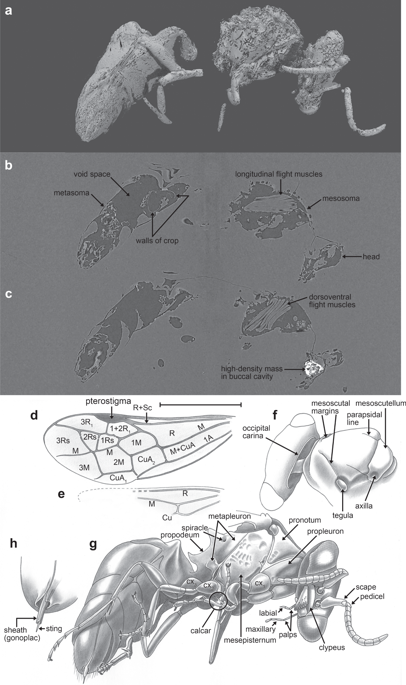当前位置:
X-MOL 学术
›
Commun. Biol.
›
论文详情
Our official English website, www.x-mol.net, welcomes your feedback! (Note: you will need to create a separate account there.)
Direct evidence for eudicot pollen-feeding in a Cretaceous stinging wasp (Angiospermae; Hymenoptera, Aculeata) preserved in Burmese amber.
Communications Biology ( IF 5.9 ) Pub Date : 2019-11-07 , DOI: 10.1038/s42003-019-0652-7 David A Grimaldi 1 , Enrique Peñalver 2 , Eduardo Barrón 2 , Hollister W Herhold 1 , Michael S Engel 3
Communications Biology ( IF 5.9 ) Pub Date : 2019-11-07 , DOI: 10.1038/s42003-019-0652-7 David A Grimaldi 1 , Enrique Peñalver 2 , Eduardo Barrón 2 , Hollister W Herhold 1 , Michael S Engel 3
Affiliation

|
Angiosperms and their insect pollinators form a foundational symbiosis, evidence for which from the Cretaceous is mostly indirect, based on fossils of insect taxa that today are anthophilous, and of fossil insects and flowers that have apparent anthophilous and entomophilous specializations, respectively. We present exceptional direct evidence preserved in mid-Cretaceous Burmese amber, 100 mya, for feeding on pollen in the eudicot genus Tricolporoidites by a basal new aculeate wasp, Prosphex anthophilos, gen. et sp. nov., in the lineage that contains the ants, bees, and other stinging wasps. Plume of hundreds of pollen grains wafts from its mouth and an apparent pollen mass was detected by micro-CT in the buccal cavity: clear evidence that the wasp was foraging on the pollen. Eudicots today comprise nearly three-quarters of all angiosperm species. Prosphex feeding on Tricolporoidites supports the hypothesis that relatively small, generalized insect anthophiles were important pollinators of early angiosperms.
中文翻译:

缅甸琥珀中保存的白垩纪刺蜂(被子植物;膜翅目,Aculeata)以双子叶植物花粉为食的直接证据。
被子植物和它们的传粉昆虫形成了一种基本的共生关系,来自白垩纪的证据大多是间接的,基于今天是人性的昆虫类群化石,以及分别具有明显的人性和昆虫性专门化的昆虫和花卉化石。我们提出了白垩纪中期缅甸琥珀(100 mya)中保存的特殊直接证据,表明一种基部新的有刺黄蜂 Prosphex anthophilos,gen. 以真双子叶植物 Tricolporoidites 中的花粉为食。等 十一月,在包含蚂蚁、蜜蜂和其他带刺黄蜂的谱系中。数百颗花粉粒从它的嘴里飘出,微型 CT 在口腔中检测到明显的花粉团:明确的证据表明黄蜂正在以花粉为食。如今,双子叶植物占所有被子植物物种的近四分之三。
更新日期:2019-11-07
中文翻译:

缅甸琥珀中保存的白垩纪刺蜂(被子植物;膜翅目,Aculeata)以双子叶植物花粉为食的直接证据。
被子植物和它们的传粉昆虫形成了一种基本的共生关系,来自白垩纪的证据大多是间接的,基于今天是人性的昆虫类群化石,以及分别具有明显的人性和昆虫性专门化的昆虫和花卉化石。我们提出了白垩纪中期缅甸琥珀(100 mya)中保存的特殊直接证据,表明一种基部新的有刺黄蜂 Prosphex anthophilos,gen. 以真双子叶植物 Tricolporoidites 中的花粉为食。等 十一月,在包含蚂蚁、蜜蜂和其他带刺黄蜂的谱系中。数百颗花粉粒从它的嘴里飘出,微型 CT 在口腔中检测到明显的花粉团:明确的证据表明黄蜂正在以花粉为食。如今,双子叶植物占所有被子植物物种的近四分之三。



























 京公网安备 11010802027423号
京公网安备 11010802027423号